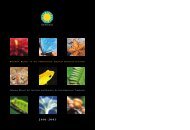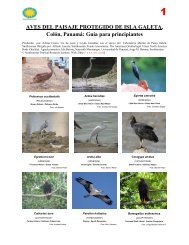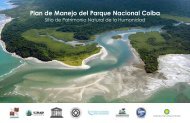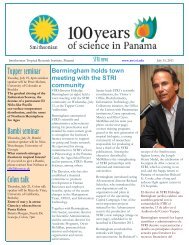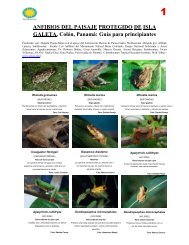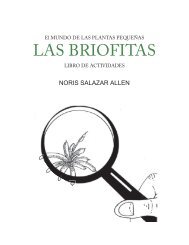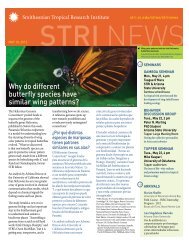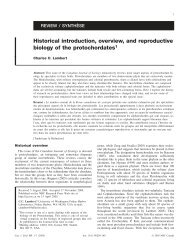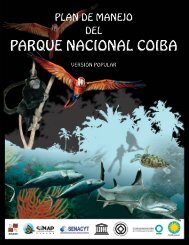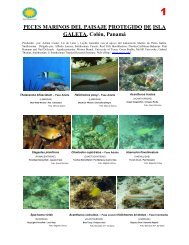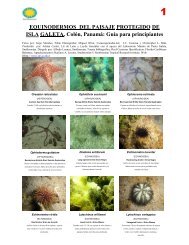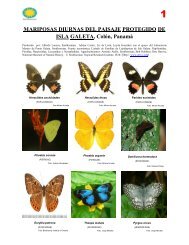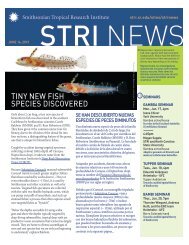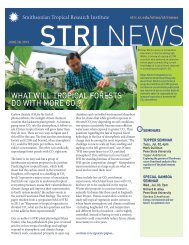Download - Smithsonian Tropical Research Institute - Smithsonian ...
Download - Smithsonian Tropical Research Institute - Smithsonian ...
Download - Smithsonian Tropical Research Institute - Smithsonian ...
You also want an ePaper? Increase the reach of your titles
YUMPU automatically turns print PDFs into web optimized ePapers that Google loves.
Vol. XXXIX: Supplement THE FESTIVUS Page 13<br />
diverse at Clipperton. Infaunal neogastropods are rare<br />
at Clipperton such as the single deeper-water species of<br />
Nassariidae (Plate 33, figures 1a-b, 2). Of the 50 taxa<br />
identified to species level, 22 are from the Indo-Pacific<br />
faunal region, while the remaining 28 are known from<br />
the Panamic Province.<br />
The Heterostropha contain 20 taxa, of which six<br />
could be identified to species level; one of those belongs<br />
to the Indo-Pacific fauna, while the remaining five are<br />
Panamic. The diversity of Architectonicidae (Plate 37)<br />
seems high, while the Pyramidellidae (Plates 38, 39)<br />
show levels of diversity comparable to other TEP<br />
oceanic islands.<br />
The Opisthobranchia (sea slugs) are represented by<br />
35 species. Of the 13 taxa identified to species level<br />
(excluding the circumtropical holoplanktonic families),<br />
ten are circumtropical or from the Indo-Pacific region,<br />
while three belong to the Panamic fauna. The mostly<br />
infaunal Cephalaspidea (Aglajidae) is represented with<br />
a single species, Navanax aenigmaticus (Bergh, 1894),<br />
which atypically, for the order, is an epifaunal species<br />
on hard substrata. The herbivores (Plakobranchidae,<br />
Aplysiidae) as well as spongivores (Umbraculidae,<br />
Chromodorididae, Discodorididae, Dendrodorididae)<br />
and species feeding on anthozoans (Aeolidiidae,<br />
Tergipedidae) are represented at Île Clipperton.<br />
Only two pulmonate land snails (Plate 41, figures 3,<br />
4) have been recorded: Opeas oparanum (Pfeiffer,<br />
1846) and Succinea atollica Hertlein & Allison, 1968,<br />
the latter described from Île Clipperton. At present,<br />
neither species can be found on the island, although both<br />
species were common in 1958. I suggest that, perhaps,<br />
the land snail populations were negatively affected by the<br />
feral pigs and later, to the point of extinction, by the<br />
millions of land crabs. Although land snails were<br />
reportedly abundant in 1958 (Sachet, 1962c), no<br />
subsequent expeditions have encountered them, either<br />
living or as empty shells.<br />
A single small chiton species described from Isla del<br />
Coco, Costa Rica, as Ischnochition victoria Ferreira,<br />
1987, was occasionally encountered living on coralline<br />
algae at Clipperton (Plate 43, figures 7, 8).<br />
The Cephalopoda are particularly problematic.<br />
Octopus spp. and some Octopus spp. paralarvae were<br />
collected during the last four Expeditions. Museum<br />
holdings contain approximately three to six species, the<br />
identity of which can not be further ascertained because<br />
a critical review of the region’s cephalopod fauna is<br />
wanting (pers. comm., F. G. Hochberg, 2007).<br />
The taxa listed from Clipperton (Appendix 1) are<br />
predominantly small-bodied species. In some cases<br />
specimens collected at Clipperton are notably smaller<br />
compared to those collected at the other rocky TEP<br />
oceanic islands. For example, the muricid Tribulus<br />
planospira (Lamarck, 1822) usually grows to 60-70<br />
mm, but at Clipperton a maximum size recorded for a<br />
mature specimen is 41 mm. The turrid Clathurella<br />
rigida (Hinds, 1843) usually grows to 8 mm but only<br />
attains a size of 4.7 mm at Clipperton. But some of the<br />
larger-bodied species, such as Cypraecassis tenuis<br />
(Wood, 1828) and C. coarctata (G.B. Sowerby I, 1825)<br />
are of comparable size to specimens found on the other<br />
TEP islands. In a single case, a world-record size<br />
specimen (60.9 mm) of Mauritia scurra (Gmelin, 1791)<br />
was collected at Clipperton (Kaiser, 1999). However,<br />
Clipperton specimens are generally smaller than those<br />
from other populations.<br />
In an odd error, Dall & Ochsner (1928) noted a<br />
“strictly Indo-Pacific” fauna on México’s Isla Clarión of<br />
the Revillagigedo group, but this seems to have been a<br />
mistake for Clipperton, because the fauna of Clarión is<br />
mainly tropical eastern Pacific (Hertlein, 1937; Kaiser,<br />
pers. obs.).<br />
Conclusion<br />
The Clipperton molluscan fauna as presently known<br />
consists of 285 species, of which 182 are here reported<br />
for the first time. The majority of species forming new<br />
records are illustrated herein. In some cases, newly<br />
collected material of better specimens has permitted the<br />
identification of formally incertae sedis species and<br />
some previously misidentified.<br />
From the statistics derived in Appendices 1 and 3,<br />
the malacofauna of Île Clipperton, identified to species<br />
level, is: tropical eastern Pacific (Panamic) (37.7%);<br />
Indo-Pacific (33.5%); inter-island endemics (8.9%);<br />
circumtropical (16.2%); endemic (2.6%) and western<br />
Atlantic (1.0%). Species with long dispersal stages are<br />
more numerous, and the species composition strongly<br />
reflects the limited hard-substrate biomes available at Île<br />
Clipperton.<br />
Acknowledgments<br />
Many people assisted in the current project; they are<br />
listed alphabetically with their respective affiliation and<br />
contribution. I am very thankful to them all for their assistance<br />
and for their valuable time spent on the project.<br />
Laurent Albenga, MNHN, still images, collecting assistance<br />
(2005)<br />
John and Dianne Arguelles, Santa Barbara, California, logistical<br />
assistance while working at SBMNH



